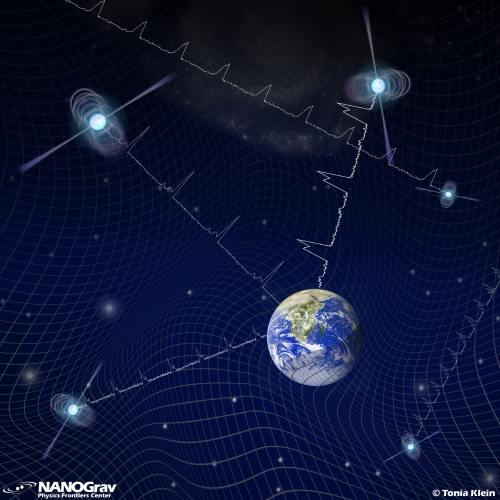Vanderbilt astrophysicists, led by Assistant Professor of Physics and Astronomy Stephen Taylor, are part of a group of researchers that may have found the first hints of low-frequency gravitational waves from supermassive black holes merging in other galaxies. The data was gathered and analyzed within the North American Nanohertz Observatory for Gravitational Waves.

The paper, “The NANOGrav 12.5-year Data Set: Search For An Isotropic Stochastic Gravitational-Wave Background,” was published in the December 2020 issue of The Astrophysical Journal Letters and discussed at a news briefing during the American Astronomical Society’s virtual meeting on Jan. 11.
According to a National Science Foundation news release, gravitational waves are a cosmic messenger signal—one that holds great potential for understanding “dark” objects, like black holes. Astronomers cannot observe these waves with a telescope as they do stars and galaxies. Instead, they measure the effects passing gravitational waves have, namely tiny changes to the precise position of objects—including the position of the Earth itself.
NANOGrav chose to study the dependable signals from pulsars. Commonly referred to as the universe’s timekeepers, these small, dense stars spin rapidly, sending pulses of radio waves toward Earth at precise intervals. This unique trait has made them useful for astronomical study.
Of the 47 most stable rotating “millisecond pulsars” that rotate hundreds of times a second, 45 provided datasets of at least three years each. This quantity of data enabled Taylor and his colleagues to identify a low frequency signature across multiple pulsars.

The findings of this research represent the first step in a broader understanding of the gravitational universe. “This is a very important milestone in the search for low frequency gravitational waves,” Taylor said. “The discovery of this signal in common across many of our precisely timed pulsars could be the tantalizing first hint of gravitational waves. We can’t say for sure yet, but we expect to know within the next couple of years.”
Definitive detection of gravitational waves will take time and innovative techniques. “The Vanderbilt group has a central position in the leadership of this research and in the development of the sophisticated tools being used to carry out the searches,” Taylor said. “The next year or two are going to be very exciting!” The work also builds on Taylor’s previous research to determine the precise center of gravity of our solar system.
“NANOGrav has been building to the first detection of low frequency gravitational waves for over a decade, and today’s announcement shows that they are on track to achieving this goal,” said Pedro Marronetti, NSF program director for gravitational physics. “The insights that we will gain on cosmology and galaxy formation are truly unparalleled.”
The NANOGrav project receives support from National Science Foundation Physics Frontiers Center award No. 1430284. The Arecibo Observatory is a facility of the National Science Foundation operated under cooperative agreement (#AST-1744119) by the University of Central Florida in alliance with Universidad Ana G. Méndez and Yang Enterprises Inc. The Green Bank Observatory is a facility of the National Science Foundation operated under cooperative agreement by Associated Universities Inc. Taylor’s work is also supported by the National Science Foundation, award No. 2007993.